Annual Report 2008-2009: Chapter 2
Annual Report 2008 - 2009
Chapter 2:
Human Rights Education
and Promotion
- 2.1 Education and communication strategy
- 2.2 Media engagement
- 2.3 Community consultations
- 2.4 Publications and resources
- 2.5 The Commission website – www.humanrights.gov.au
- 2.6 Electronic mailing lists
- 2.7 Human Rights Education Program for schools
- 2.8 2008 Human Rights Medals and Awards
- 2.9 2008 Human Rights Photography Competition
One of the Commission’s central functions is to undertake education programs that increase public awareness and generate discussion of human rights and anti-discrimination issues within Australia.
The Commission’s legislative responsibilities are:
- To promote an understanding and acceptance of, and compliance with, the following Acts:
- Human Rights and Equal Opportunity Commission
Act section 11(1)(g) - Racial Discrimination Act section 20(1)(b)
- Sex Discrimination Act section 48(1)(d)
- Disability Discrimination Act section 67(1) (g)
- Age Discrimination Act section 53(aa).
- Human Rights and Equal Opportunity Commission
- To undertake research and education programs for the purpose of promoting the objects of the following Acts:
- Human Rights and Equal Opportunity Commission Act section 11(1)(h)
- Racial Discrimination Act section 20(1)(c)
- Sex Discrimination Act section 48(1)(e)
- Disability Discrimination Act section 67(1)(h)
- Age Discrimination Act section 53(ac).
These legislative responsibilities reflect Australia’s international obligation to provide human rights education. In the earliest international articulation of universal human rights, the Universal Declaration of Human Rights, the General Assembly proclaimed:
every individual and every organ of society, keeping this Declaration constantly in mind, shall strive by teaching and education to promote respect of these rights and freedoms and by progressive measures, national and international, to secure their universal and effective recognition and observance.
2.1 Education and communication strategy
Education is a crucial area of the Commission’s work. At a basic level, everything the Commission does – from resolving individual complaints to holding national inquiries – contributes to human rights education and communication.
The aims of the Commission’s education and communications program are to:
- raise awareness about human rights and responsibilities, within the Australian context
- stimulate discussion around key human rights issues
- promote community engagement with human rights
- promote awareness of the Commission’s complaint process and rights protected under its laws
- provide information about human rights to the widest possible audience in a range of accessible formats.
The Commission uses a range of strategies to communicate its key messages, including:
- media engagement, with metropolitan, regional and specialist press, radio and television outlets
- the President, Commissioners and staff holding consultations with a range of Non Government Organisations (NGOs) (including peak bodies), community groups, parliamentarians, business and industry groups, academics and government officers
- an extensive and accessible website which includes human rights information and education materials for students, teachers, employers, government, media, community groups and individuals
- curriculum-linked human rights education materials for teachers and students which are promoted online and at education/teaching conferences, workshops and forums around the country
- new web technologies and social networking sites (such as, Facebook, YouTube, My Space and Twitter) and popular media (such as, blogs, bulletin boards and e-forums)
- publishing and distributing plain English reports, discussion papers, brochures, posters and other resources (CD-Roms and DVDs) on human rights and discrimination issues
- hosting conferences, seminars, forums and events, such as the annual Human Rights Medals and Awards ceremony.
Specific human rights educational and promotional programs conducted by individual Commissioners are detailed later in this Report.
2.2 Media engagement
The Commission has consistently engaged with the media to promote human rights issues. This is a crucial element of the Commission’s public education function.
The President and Commissioners are frequently interviewed by newspapers, television, radio and online media outlets, as well as specialist, Indigenous and ethnic media.
Extensive coverage of major Commission reports has been critical in drawing public attention to important human rights issues and bringing about positive change in attitudes, laws and policies.
In 2008-09, the Public Affairs unit received over 1100 media enquiries. In response, the President and Commissioners granted in excess of 520 media interviews, which resulted in a significant amount of print, radio, internet and television coverage. The Commission issued 151 media releases and the President and Commissioners had 21 opinion pieces published in major metropolitan newspapers and journals around Australia. All Commission media releases, opinion pieces and speeches are available at: www.humanrights.gov.au/about/media.
The Commission’s President and three Commissioners contributed to public debate through the media on a diverse range of human rights, equality and discrimination issues.
Upon taking up her position with the Commission, President Branson spoke to the media on a number of occasions about her expectations of the position and her plans for her term as President of the Commission. Ms Branson also engaged with the media on a range of human rights issues, including most notably issues that arose in the context of the National Human Rights Consultation. In 2009, Ms Branson engaged in an email exchange with the NSW Attorney-General, Mr John Hatzistergos, regarding the merits of a Human Rights Act for Australia. This exchange was published in The Australian newspaper.
Aboriginal and Torres Strait Islander Social Justice Commissioner, Tom Calma was sought out by the media for comment on a number of significant issues including: the Northern Territory Emergency Response Review Board’s report and the government’s response to it; the government’s performance in Indigenous affairs after their first year in power; changes to the Native Title Act; and Mr Calma’s appointment to convene the National Indigenous Representative Body Steering Committee. Other significant issues that Commissioner Calma was interviewed about included: the incidence of suicides in the Narrogin Aboriginal community; the Homelands policy in the Northern Territory; the Queensland Government’s Wild Rivers Declaration and the issues it raised in terms of Indigenous human rights. He also provided comment as leader of Close the Gap, the campaign to achieve equality in health status and life expectancy for Indigenous Australian by 2030. Commissioner Calma was also interviewed and profiled in GQ Australia in relation to his nomination for the magazine’s 2008 Men of the Year Awards, for which he ultimately won Man of Inspiration.
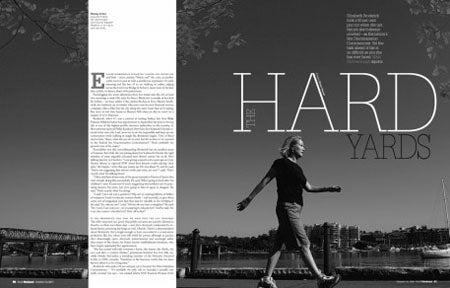
...............
The President and Commissioners were extensively interviewed in the media during 2008-09. In October 2008, a profile of the Sex Discrimination Commissioner ran as a feature article in the Sydney Morning Herald and The Age Good Weekend magazine.
As Race Discrimination Commissioner, Mr Calma provided comment on issues which included: the use of dog patrols by Ceduna and Port Augusta Shire Councils in South Australia to police dry drinking zone areas; the Commission’s Freedom of religion and belief in the 21st century discussion paper; the Commission’s national consultation with African Australians; and the issue of whether Australia is a racist country in relation to violent incidents involving foreign students.
Disability Discrimination Commissioner, Graeme Innes, was interviewed in the media about a number of subjects, including: accessibility and captioning in movies; accessibility of government and agency websites; the Government Disability Employment Strategy; the draft Disability (Access to Premises – Buildings) Standards; and accessibility for people with disability in education.
As Human Rights Commissioner, Mr Innes spoke to the media about issues which included: the removal of discrimination against same-sex couples and their children from 84 pieces of federal legislation at the end of 2008; the Commission’s Sex files sex and gender diversity project and report; and the Commission’s change of name from the Human Rights and Equal Opportunity Commission. Commissioner Innes was also interviewed about: the federal government’s inquiry into immigration detention; its announcement of new directions for immigration and detention; the Commission’s 2008 Immigration detention report; and the detention conditions on Christmas Island. Additionally, Mr Innes was interviewed by the media in various states and the Northern Territory about the workshops the Commission conducted around Australia in relation to the government’s National Human Rights Consultation.
Sex Discrimination Commissioner, Elizabeth Broderick, undertook over 60 interviews in relation to the launch of her agenda for her term as Sex Discrimination Commissioner on 22 July 2008. Ms Broderick also devoted a significant amount of time to engaging with the media as a high profile advocate for the implementation of a paid parental leave scheme, funding for which was announced in the May 2009 Federal Budget. She was also interviewed about: her views on the ways in which the Sex Discrimination Act should be amended; the results of the Commission’s Sexual harassment national telephone survey; and gender pay inequality and the glass ceiling, as discussed in the Equal Opportunity for Women in the Workplace Agency Australian Census of Women in Leadership report. Ms Broderick was also interviewed for an extensive profile in the Sydney Morning Herald and The Age Good Weekend magazine. On 29 April 2009, Ms Broderick addressed the National Press Club of Australia about the impact of the economic slowdown on efforts to progress gender equality, and thereafter undertook a number of interviews concerning its content with radio, television and print media around the country.
Each year the Commission promotes the annual Human Rights Medals and Awards, which includes categories to recognise the outstanding contribution to human rights through the print media, radio or television. To assist in its promotion, President Branson completed a number of interviews in advance of and after the event.
2.3 Community consultations
Community consultations provide a valuable opportunity for the exchange of information between the Commission and the many different organisations with which it works.
During 2008-09 the President, Commissioners and Commission staff met with a wide range of peak bodies, community groups, NGOs, government agencies, business and industry groups, parliamentarians, lawyers and academics.
Community consultations have been the foundation of recent projects that have aimed to investigate prejudice against Arab, African and Muslim Australians, understand discrimination faced by the sex and gender diverse communities and to respond to concerns regarding changes in Indigenous affairs.
The Commission also employs seminars and workshops as a means of sharing information about its activities, such as its complaint handling role, or to discuss emerging issues in human rights law.
Consultations held during the reporting period included:
- The Disability Discrimination Commissioner and staff were involved in numerous meetings with community organisations, advocacy groups, academics, employers and employer groups, federal and state ministers, and other members of parliament.
- The Sex and Age Discrimination Commissioner was involved in approximately 180 meetings. These consultations have been with comm-unity organisations and activists, academics, employers and employer groups, unions, federal Ministers and other Members of Parliament.
- The Race Discrimination Commissioner and staff held approximately 80 meetings with external stakeholders and community members. In addition, a number of staff attended the New Zealand National Diversity Forum and met with staff from the New Zealand Human Rights Commission and a range of stakeholders to discuss issues of common concern, including those in relation to the Muslim community projects.
- The Aboriginal and Torres Strait Islander and Social Justice Commissioner and staff held approximately 83 community meetings/consultations, including the consultation organised for the new National Indigenous Representative Body and the government’s National Human Rights Consultation.
- The Human Rights Commissioner and staff held approximately 151 meetings, which included consultations with people who are sex and gender diverse, regarding human rights issues that affect them.
- Complaint Service: A range of organisations across Australia either attended information sessions on the law and the complaint process run by Complaint Handling Section (CHS) staff, or were visited by CHS staff. These organisations included: community legal centres; professional associations and unions; legal and advocacy services for women, youth, people with disabilities and older people; multicultural organisations; colleges and universities. Locations visited included Sydney, Nambucca Heads, Coffs Harbour, Ballarat, Melbourne, Canberra, Brisbane, Adelaide and Perth.
2.4 Publications and resources
Each year, the Commission produces a range of hard copy publications and resources, which generally fall into the following categories:
- fact sheets
- posters
- information brochures/booklets
- community guides
- project discussion papers
- large researched reports tabled in parliament, such as national inquiry reports or the Annual Report
- online publications for the Commission website, such as the education resources and the resources for employers
- CD-ROMs/DVDs, which offer an alternative format in which to publish materials printed in hard-copy or online formats.
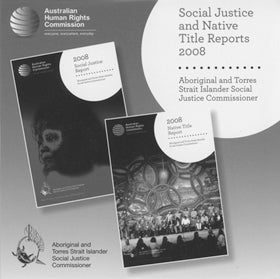
...............
The Commission’s publications and resources are produced in a range of formats including CD-ROM and DVD.
In 2008-09, a total of 75 021 publications were sent out to 4868 requests. This is an increase in the number of publications distributed in 2007-08.
These figures do not take into account the number and location of resources distributed by Commissioners and Commission staff as part of consultations, seminars and other public engagements.
The Commission’s major inquiries and reports are usually accompanied by community guides which focus on translating the detailed investigations into easily accessible information designed to educate both the affected communities and the community-at-large.
In 2008-09, the following community guides were produced:
- 2008 Social Justice and Native Title Reports
- 2008 Climate change, water and Indigenous knowledge
- 2008 Close the gap
- 2009 Getting it right: progress towards a new National
Indigenous Representative Body.
Most Commission publications can also be downloaded in electronic format from the website.
The online publications page provides links to lists of publications by subject area, an order form and a list of recent publications.
A list of publications released during 2008-09 can be found at Appendix 2 of this Report.
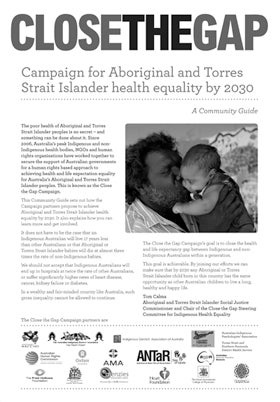
...............
The Commission produces easily accessible summaries of its major inquiries and reports, called community guides, for the benefit of both the affected communities and the community-at-large. Four new community guides were produced during 2008-09.
2.4.1 New publishing guidelines and style guide
The Commission developed a new internal style guide and publishing guidelines to help streamline the publication production processes.
The guidelines and guide have helped to ensure that the Commission’s brand consistency is maintained and publications and resources are produced in a timely, efficient and cost-effective manner.
2.4.2 Translations
The Commission publishes material in a wide range of formats.
In 2008, the Commission produced a poster with complaints information in 16 languages which has been distributed to 3000 multicultural centres around Australia.
The Commission also provides online translations of some core publications in various languages, including the general Australian Human Rights Commission brochure and Commission’s complaint process brochure.
2.4.3 Accessibility
The Commission ensures that, where possible, resources are published in formats that are accessible to people with disability.
Requests for publications in large print, Braille, or audio are dealt with on a case by case basis.
When producing CDs and DVDs, the Commission considers a range of principles regarding accessibility requirements.
2.5 The Commission website – www.humanrights.gov.au
The Commission’s website was established in 1998. Since that time it has become the organisation’s primary mode of information dissemination. It is widely used by government, the media, students and teachers, lawyers, employer organisations, NGOs and the wider community to obtain information about human rights and responsibilities and anti-discrimination law and practice.
The website is updated daily to ensure information is current and accurate. All reports, submissions, speeches, media releases and other Commission publications are available online in a variety of formats.
Web resources also include an online complaints form and information for complainants and respondents, a range of curriculum-linked human rights education resources for schools, information resources for employees and employers, a legal section which provides full details of legislation and other legal issues, and information on the work of the President and Commissioners and their policy areas.
In 2008-09, the Commission website design was modified to match the new Commission styles and colours.

...............
Daily updates ensure the Commission website, which has become the organisation’s primary mode of information dissemination, is both current and accurate.
2.5.1 Web 2.0 technologies and social networking
In the last year, the Commission has made greater use of Web 2.0 technologies and utilised social networking approaches in its communications strategies. This includes:
- launch of the Commission Facebook page on 26 March 2009, which allows subscribers to be notified about events and projects that the Commission is promoting
- launch of the Commission YouTube channel on 22 April 2009, which features a range of videos from Commissioners and Commission projects
- launch of a Commission MySpace page on 6 May 2009, to promote
the Commission’s project on the National Human Rights Consultation – Let’s talk about rights - use of Twitter accounts by Commissioner Innes and Commissioner Broderick
- use of RSS and Podcasting for media releases and speeches from Commission events
- the Sex files blog, which ran from 8 August to 5 December 2008, for consultation and engagement with the sex and gender diverse community during the sex and gender diversity project
- use of more established web publishing processes (e.g. posting submissions in public inquiry processes online as they are received).
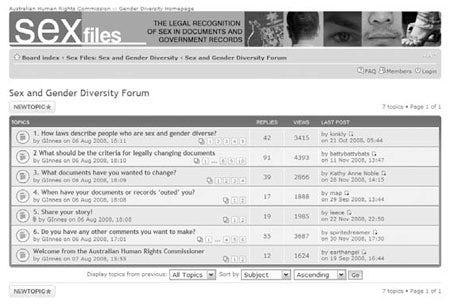
...............
The Commission continues to increase its use of Web 2.0 technologies and social networking media. As part of the consultation for the Sex and gender diversity project, an online blog was implemented, which allowed participants the option of providing anonymous blog comments.
2.5.2 Sex files blog
In August 2008, the Commission developed the Sex files blog as part of the sex and gender diversity project, which looked at the difficulties that people who are sex and gender diverse experience in being identified in official documents and government records. The online blog was designed to involve the sex and gender diverse communities in the development of recommendations regarding the legal recognition of their sex. Comments on the blog were public, but participants could choose to post anonymously.
When the blog closed on 5 December 2008, there were more than 140 registered users of the blog, and more than 400 posts.
The blog received 317 173 page views, which equates to approximately
624 677 hits and 29 627 unique visits.
The blog was advertised through postcards and posters which were distributed to medical professionals and organisations, universities and support groups.
A selection of comments from the blog was used in the concluding paper of the project.
For more information about the sex and gender diversity project, refer to Chapter 8.
2.5.3 Information for employers and employees
The Commission has a commitment to educating employers and employees about human rights and responsibilities under federal anti-discrimination laws.
The Commission has developed four short fact sheets setting out five basic steps towards integrating human rights into everyday business practices.
The fact sheets explain how human rights are relevant to Australian companies and set out the case for integrating human rights into their business practices. They also include information specific to the finance sector, the mining and resources sector and the retail and manufacturing sectors.
See humanrights.gov.au/human_rights/corporate_social_responsibility/index.html.
In December 2004, the Commission launched an information resource for employers, entitled Good practice, good business, which provides practical information about dealing with discrimination and harassment in the workplace. In response to feedback from employers, the Commission is currently updating the resource with new information and making the existing content more relevant and accessible. The resource is available at: www.humanrights.gov.au/info_for_employers.
Information for employees is available at: www.humanrights.gov.au/complaints_information/WOYR.html.
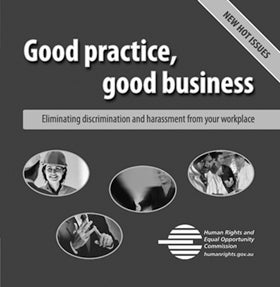
...............
The Commission is currently updating the Good practice, good business resource to make it more relevant and more accessible.
2.5.4 Statistics
The Commission uses a web statistics system that tracks both the number of visitors to the site and the way visitors use the site. This allows the Commission to identify materials that are particularly successful or popular and other areas that are not accessed as often.
During 2008-09, the site received approximately 18 460 234 page views on the server. This equates to approximately 93 769 855 hits on the site in total and 3 300 132 unique visits.
A summary of statistical information is provided below:
|
Table 2: Visitors to the Commission website by page view
|
|||
|
Section
|
Views of section home page
|
Views of all pages in section
|
|
|
Commission homepagewww.humanrights.gov.au
|
58 827
|
n/a
|
|
|
Aboriginal and Torres Strait Islander Social Justicewww.humanrights.gov.au/social_justice/
|
92 354
|
1 102 424
|
|
|
Complaints Informationwww.humanrights.gov.au/complaints_information/
|
59 066
|
319 217
|
|
|
Disability Rightswww.humanrights.gov.au/disability_rights/
|
78 350
|
1 355 896
|
|
|
Human Rightswww.humanrights.gov.au/human_rights/
|
86 608
|
911 090
|
|
|
Legal Informationwww.humanrights.gov.au/legal/
|
62 740
|
987 101
|
|
|
Racial Discriminationwww.humanrights.gov.au/racial_discrimination/
|
65 510
|
451 388
|
|
|
Sex Discriminationwww.humanrights.gov.au/sex_discrimination/
|
99 259
|
397 277
|
|
|
Age Discriminationwww.humanrights.gov.au/age/
|
53 970
|
102 389
|
|
|
Information for Employerswww.humanrights.gov.au/info_for_employers/
|
26 921
|
261 549
|
|
|
Publicationswww.humanrights.gov.au/about/publications/
|
94 440
|
n/a
|
|
|
Media Releases Indexwww.humanrights.gov.au/about/media/media_releases/
|
16 475
|
696 924
|
|
|
Job Vacancieswww.humanrights.gov.au/about/jobs/
|
46 894
|
55 127
|
|
|
Human Rights Education Resourceswww.humanrights.gov.au/education/
|
51 669
|
1 061 313
|
|
2.6 Electronic mailing lists
The Commission offers subscription electronic mailing lists which allow it to communicate up-to-date information about current human rights issues, both at a domestic and international level.
Interested parties can subscribe to a variety of mailing lists which are offered on the basis of specific interests, including human rights education, information for employers, legal and complaints, human rights, Indigenous, disability rights, racial discrimination, sex discrimination and Human Rights Awards. Subscribers can also join a priority list and receive the entire set of information sent to all lists.
At the end of the reporting period, there were 21 113 subscribers across the various electronic mailing lists. To join the mailing lists go to https://humanrights.gov.au/about/mailing-lists
The Commission also maintains ongoing communication with teachers and education bodies through an electronic mailing list, providing regular updates about:
- the most recent human rights education activities
- reviews and links to human rights education resources
- reviews of particular sections of the Commission’s website
that would be useful to educators - upcoming human rights education events.
2.7 Human Rights Education Program for schools
The Commission’s Human Rights Education Program aims to help students develop a critical understanding of human rights and responsibilities, as well as develop the attitudes, behaviours and skills to apply them in everyday life. It is guided by a clear set of education principles and learning outcomes.
The Commission’s approach supports the goals and direction of the World Programme for Human Rights Education. The Programme’s first phase
(2005-09) focused on supporting human rights education in primary and secondary schools.
The Commission works with Australia’s state and territory education departments, schools, organisations and facilitators to promote an understanding of and commitment to human rights education.
Many schools, principals and individual teachers have made concerted efforts to integrate human rights education into their teaching practice, classroom activities and school communities.
The Commission produces a wide range of human rights education resources for teachers, which can be downloaded free. There are resource sheets, worksheets and interactive activities, along with links to useful Australian and international websites.
The Commission also plays an ongoing lobbying role to ensure ‘human rights’
is covered within curricula and in school policies and programs.
2.7.1 Human rights education principles
The resources that make up the Human Rights Education Program draw students into real-life situations which are relevant to their own experiences and can be explored in the context of Australian and international law.
The teaching and learning activities that are published by the Commission are designed to be:
- contextual, where human rights are discussed in social contexts relevant to the learners
- skills-oriented, where human rights education develops skills, and is linked with literacy, numeracy and decision making skills
- cross-curricular, where human rights, as human experience, are relevant to all aspects of learning
- discursive, where learning is based on discussion, exchanging ideas and values, understanding human communication
- inclusive, where all students, regardless of their learning styles or abilities, can participate.
2.7.2 Educational outcomes
The Commission’s human rights education resources are designed to assist students to develop:
- an understanding of what human rights are and an understanding of the origins of modern human rights
- an appreciation of the meaning and significance of the Universal Declaration of Human Rights and other human rights instruments
- an understanding of how human rights instruments are applied in Australian law and society
- an ability to apply the concepts of human rights to their daily lives
- an understanding of issues concerning asylum seekers and refugees, migrants and multiculturalism and Aboriginal and Torres Strait Islander peoples
- research and fact-sourcing skills, and an ability to think creatively and to communicate information to others
- decision making skills, within an individual, group and class context
- literacy skills, including critical literacy, code breaking and comprehension skills, through reading and responding to a variety of texts, both orally and through writing
- skills in describing, reflecting, interpreting, analysing, evaluating and higher order thinking.
2.7.3 Educational content
The Commission has linked its core human rights education resources with curriculum frameworks from education department’s across each Australian state and territory.
Links have been established in a range of key learning areas including: Studies of Society and Environment (especially Aboriginal Studies and Australian Studies), English, Civics and Citizenship/Discovering Democracy, Geography, History and Drama.
The resources provide significant flexibility for delivery and teachers can incorporate individual activities into an existing program or teach the module as a whole.
2.7.4 Educational resources
The Commission’s Human Rights Education Program includes a range of interactive, resource-rich, web-based learning modules for use in the classroom with students ranging in age from 10 to 17 years.
The resources are designed to introduce Australian students to human rights concepts in an engaging, relevant way. They provide useful secondary resources and lesson plans to teachers for use with a range of age and ability groups, at schools, universities, workplaces and community education centres.
Activities aim to promote a human rights approach to learning, where all students are encouraged to participate in the learning process.
Educational activities are available under the following topic headings:
- child rights
- disability rights
- human rights
- Indigenous rights
- multiculturalism
- race relations
- sexual harassment.
The Commission’s human rights education resources are available online at: www.humanrights.gov.au/education.
The Commission is currently revising and redeveloping its schools education activities and modules into one ‘Human Rights Education Resource’, which will provide high quality, informative human rights education resources for teachers and students.
This resource will bring together the education materials developed by the Commission over the past 10 years.
It will provide comprehensive and easy-to-use guidance for teachers and students on a variety of human issues like the Stolen Generations, refugees, sexual harassment, diversity and other important discrimination and human rights issues.
2.7.5 New and updated education resources
Over the last financial year the Commission has developed and updated the following education resources for inclusion in the program:
- updated the teacher and learning activities around child rights
- updated the Human rights explained fact sheets
- updated the teaching notes, student activities and worksheets to fit in with the updated Face the facts: questions and answers about refugees, migrants and Indigenous people publication
- developed It’s your right! resource kit, in partnership with Adult Multi-cultural Education Services Victoria, as a teaching resource about human rights and responsibilities in Australia for people who are newly arrived in the country and who are learning English as a second language. See the resources at: humanrights.gov.au/education/esl/index.html.
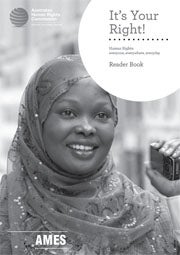
...............
The Commission produces a wide range of human rights education resources for teachers and students, such as the It’s your right! resource kit, produced during 2008-09.
2.7.6 Information for students webpage
Information for students is an online education resource for secondary school students designed to help them gain an awareness and understanding of human rights, their origin and history, the development of international human rights norms and contemporary human rights issues in Australia.
It is a multi-layered website section that draws students through a range of human rights issues.
It includes a ‘plain English’ guide to what human rights are, common questions and answers about human rights, and an explanation of the Universal Declaration of Human Rights.
It also includes more detailed information on issues such as Indigenous social justice, ‘stolen children’, refugees and asylum seekers, sexual harassment and discrimination; and human rights in other countries.
Information for students is also linked to other areas of the Commission’s website that may interest students. The site can be found at: www.humanrights.gov.au/info_for_students/.
2.7.7 Promotion and distribution of educational resources
The Commission promotes its education resources nationally at conferences, forums and lectures. The President and Commissioners often provide keynote addresses and/or speeches to educational conferences.
The Commission regularly promotes its human rights resources by sending promotional flyers, CD-ROMs, DVDs and other hard copy education materials to professional teachers associations and schools.
The Commission has also developed partnerships with educational groups and institutions that distribute the Commission’s information and education resources to teachers and students.
2.7.8 Usage of online educational resources
The Commission’s online human rights education resources are widely used by educators, both nationally and internationally. During the 2008-09 financial year, the resources received 1 061 313 page views. The main resources are listed in Table 3.
|
Table 3: Usage of the Commission’s online human rights education resources
|
|
|---|---|
|
Human rights education resources
|
Page views
|
|
Voices of Australia education module
|
98 247
|
|
Youth challenge education module
|
57 267
|
|
Bringing them home education module
|
67 017
|
|
Information for teachers web-section
|
532 963
|
|
Information for students web-section
|
128 312
|
|
Face the facts education resources
|
30 889
|
|
Human rights explained fact sheets
|
37 409
|
2.8 2008 Human Rights Medals and Awards
The prestigious Human Rights Medal and Young People’s Human Rights Medal recognises individuals who have made an outstanding contribution to the promotion and protection of human rights in Australia. Seven additional award categories recognise and acknowledge outstanding contributions to human rights, social justice and equality made by individuals and organisations.
The 21st Human Rights Medals and Awards ceremony was held in the Grand Ballroom at Sydney’s Sheraton on the Park Hotel on Wednesday, 10 December from midday to 3pm.
Television personality, Julian Morrow, was the MC, 380 people attended the gala awards ceremony, and President Branson delivered her inaugural Human Rights Day Oration, available on-line at: www.humanrights.gov.au/about/media/speeches/speeches_president/2008/20081210_Oration.html. During the ceremony, a specially recorded Human Rights Day video message from the UN Secretary-General, Mr Ban Ki-moon, was played to the audience.
Winners of the Human Rights Medals and Awards, as well as highly commended nominees from a strong field for each of the categories, were announced at the ceremony and presented with trophies and prizes.
The Commission congratulates all the winners, highly commended and shortlisted entrants for their achievements, and thanks all of those who nominated for their support of the Awards, as well as their commitment and dedication to promoting human rights in Australia.
Further information about the awards, including audio of acceptance interviews, is available on the Commission website at: www.humanrights.gov.au/hr_awards/index.html.
2.8.1 Human Rights Medal
The Human Rights Medal is awarded to an individual who has made an outstanding contribution to the advancement of human rights in Australia.
Winner: Mr Les Malezer
The Human Rights Medal was awarded to Mr Les Malezer, who is a formidable figure in Indigenous affairs, both domestically and on the international scene.
Mr Malezer is a Gubbi Gubbi and Butchulla man from the Mary River and Fraser Island region in eastern Queensland. During his more than 30 years experience in policy and program roles in the Commonwealth and Queensland public services and Indigenous organisations, he has campaigned for Aboriginal and Torres Strait Islander self-determination.
In 1977, Mr Malezer was instrumental in the development of the Foundation for Aboriginal and Islander Research Action (FAIRA), a community-owned and managed organisation concerned with human rights issues for Indigenous peoples. He is presently its Chairperson.

...............
Mr Les Malezer is presented with the 2008 Human Rights Medal by Attorney-General, Mr Robert McLelland MP.
Mr Malezer has also worked for the National Aboriginal Congress and for ATSIC. In recent years, he has focussed on working towards the improvement of access to justice and human rights for indigenous peoples worldwide. He was elected by indigenous peoples of the world to lead the Global Indigenous Caucus to the UN to galvanise support for the Declaration on the Rights of Indigenous Peoples.
Mr Malezer is respected by UN member States, treaty bodies, NGOs and diplomats alike.
His capacity to overcome seemingly insurmountable barriers is an inspiration and a lesson for all those who work on human rights and social justice issues.
2.8.2 Young People’s Human Rights Medal
Winner: Mr Alan Huynh
The Young People’s Human Rights Medal was awarded for the first time this year. The recipient was University of Queensland medical student, Mr Alan Huynh, for his tireless work in multicultural community development, youth engagement and global health issues.
Mr Huynh received clinical training at Cho Ray Hospital in Vietnam, holds a John Flynn Scholarship and has completed a rural general practice placement in Central Queensland.
He has worked with various youth advisory committees, including the Inspire Foundation and Australian Red Cross (NSW) and has held leadership positions with the Asia-Pacific Model United Nations Conference.
In 2007, Mr Huyh was given the Auburn Young Citizen of the Year award in recognition of his achievements and advocacy on behalf of young people. In 2006, he was selected as a youth ambassador on the 18th Ship for World Youth, an initiative which aims to promote cross-cultural understanding and international cooperation among young people by exchanging knowledge and experiences through open dialogue and practical learning activities.
Mr Huynh is currently a volunteer tutor for the Queensland Program for Survivors of Torture and Trauma.
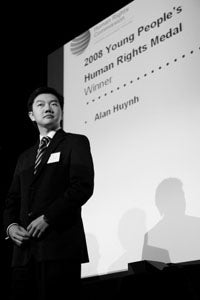
...............
Mr Alan Huynh received the 2008 Young People’s Human Rights Medal for his work in multicultural community development, youth engagement and global health issues.
2.8.3 Law Award
Winner: Mr Bill Mitchell
Mr Bill Mitchell is the Principal Solicitor of Townsville Community Legal Centre. For 14 years, he has worked tirelessly to promote equality, justice and fairness for all members of the community, particularly those most in need.
The work of the Townsville Community Legal Centre encompasses disability services, anti-discrimination services, welfare services and many other areas. In his work here, Mr Mitchell has worked to increase awareness of issues of injustice and inequality in the community by drawing upon his broad grasp of a wide variety of legal issues. His contributions to the development of legal education programs, and provision of legal advice and submissions to further law reform, have resulted in community legal centres being able to provide greater access to justice. Mr Mitchell has also assisted the community to confront discrimination by mounting test cases. He has assisted those whose rights have been infringed by undertaking extensive casework and promoted greater harmony throughout Queensland and the national community by playing an active role in committees.
In addition, he has helped increase the awareness of injustice with his contributions to both practical and academic education.
This award recognises Mr Mitchell’s work in the promotion and advancement of human rights through the practice of law, as well as the inspiration, dedication, compassion and humility that he brings to his work.
2.8.4 Community Award (Individual)
Winner: Ms Sharon Boyce
This award recognises Ms Sharon Boyce for her remarkable efforts in development of a first-of-its-kind mobile disability and diversity awareness program.
Ms Boyce was diagnosed with Juvenile Chronic Arthritis when she was almost 12 years old, a condition that has since resulted in her becoming highly physically disabled. However, her attitude is ‘Live life to the full and enjoy it every day’, which has driven her to some extraordinary achievements.
Among other things, Ms Boyce is the author of a children’s book, entitled Discovery at Paradise Island, which enables children to learn about physical disability, as well as an educational resource kit called A day in the life...of a person with a physical disability. She also created Discovery Disability, a website and educational portal for children, educators and community members. Ms Boyce holds a Masters of Education (Honours) at the University of Southern Queensland and is currently working on her Doctor of Philosophy on inclusive education and diversity at the University of Queensland. She is a registered teacher, part-time tutor, online and distance education lecturer and public speaker.
Ms Boyce has received this award for Discovering DisAbility and Diversity, her mobile disability and diversity awareness program which travels to regional and rural communities throughout Queensland, educating people about difference and promoting inclusive classrooms. The program is built around experiential learning and, with Dr Michael Furtado, Ms Boyce has taken it to over 1000 schools, preschools and childcare centres, as well as provided professional development to many teachers and educators.
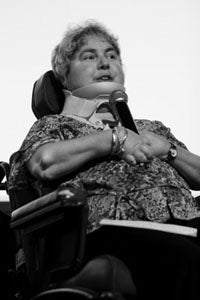
...............
Ms Sharon Boyce received the Community Award (Individual) for development of her mobile disability and diversity awareness program, which is the first of its kind.
2.8.5 Community Award (Organisation)
Winner: Refugee and Immigration Legal Service (RAILS)
Located in West End, Brisbane, RAILS is an independent not-for-profit organisation and the only organisation in Queensland that specialises in refugee and migration law. RAILS works with a large team of volunteers to provide free legal advice, assistance and community education to disadvantaged people. With a demand that far exceeds its resources, it advocates in the cases of most need before the Department of Immigration, review tribunals and, on occasions, to judicial review.
RAILS began in 1980 as a volunteer advice service at the then Brisbane Migrant Resource Centre. It did not receive government funding until 1984, when its first staff member was employed part-time.
Since then, RAILS has assisted waves of refugees, and their families, from countries suffering from major political humanitarian crises. It works closely with other support organisations to provide a network of support for the most vulnerable clients. RAILS has provided advice and assistance to a wide range of people, including onshore and offshore refugees and asylum seekers, migrants, sponsors of migrants, migrant women suffering from domestic violence and Australian citizens seeking to sponsor relatives in need, spouses and employees.
This award recognises the tireless and ongoing efforts of this organisation over the last three decades.
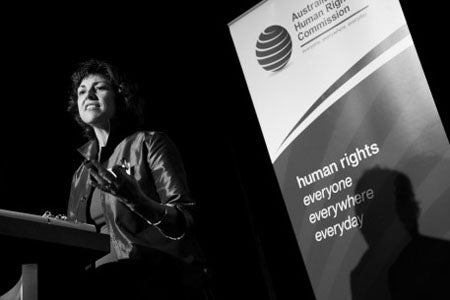
...............
Ms Sonia Caton accepts the Community Award (Organisation) on behalf of Brisbane’s Refugee and Immigration Legal
Service (RAILS).
2.8.6 Radio Award
Winner: Central Australia produced by Damien Carrick and Anita Barraud – ABC Radio National, The Law Report
As the country prepared to change government in late 2007, The Law Report aired Central Australia, a three-episode series that dealt with Indigenous legal issues in central Australia. Using the remote communities of Hermannsberg and Mutitjulu as case studies, The Intervention first examined how Indigenous people had been grappling with radical changes, particularly income management, since the Howard Government had launched its emergency intervention in June 2007. Moving to the town camps of Alice Springs, Regulating Grog then looked at the extent to which regulating the way alcohol is sold, and where it is consumed, can reduce the enormous problems associated with it in Indigenous communities.
Finally, Bush Courts examined the bush courts of the remote communities of the Northern Territory – accessible and flexible local courts that do not hear serious cases like rape and murder, but are used by groups such as the Ngaanyatjatjara Yankunytjatjara Women’s Council to try and protect women and children from domestic violence and abuse.
This award was presented to the series for its comprehensive depiction of the real impact of the Northern Territory intervention.
2.8.7 Print Media Award
Winner: The National Apology: Commemorative lift-out, edited by
Kirstie Parker for Koori Mail
This edition of Koori Mail was full of images, colourful quotes and transcripts of the speeches that commemorated this historic day. It was recognised for being an enduring record of the momentous and symbolic day when our Prime Minister officially said ‘Sorry’ to the Stolen Generations.
2.8.8 Literature Non-Fiction Award
Winner: Human Rights Overboard: seeking asylum in Australia, by Linda Briskman, Susie Latham and Chris Goddard
Until 2005, the operations within Australia’s immigration detention centres had been largely shrouded in official secrecy and the Howard Government had refused to conduct a broad-ranging investigation into immigration detention. In the wake of the Cornelia Rau scandal, all that changed. A citizen’s inquiry – the People’s Inquiry into Detention (as it came to be called) – was established to bear witness to events in Australia’s immigration detention facilities, hearing heartbreaking evidence about the journeys of asylum seekers to Australia, the refugee determination process and their lives in and after detention.
Human Rights Overboard drew together, for the first time, the oral testimony and written submissions from the inquiry in a powerful and haunting account drawn from the voices of former and current immigration detainees, refugee advocates, lawyers, doctors, psychiatrists and former detention and immigration staff.
Together, these voices record a humanitarian disaster and this book was recognised for the clear and comprehensive warning that it represents to current and future policy makers.
2.8.9 Television Award
Winner: In my shoes, produced by Steve Taylor for Four Corners, screened on ABC TV
This program took viewers into the lives of families caring for the profoundly disabled, showing carers robbed of their own independence, but fighting fiercely for the future of their loved ones. Though they are often bone weary, stressed and increasingly desperate, Australia’s 2.6 million family carers continue to care for someone else’s needs. Many live in poverty. Most are women. Yet, together, they save the taxpayer around $31 billion a year while they are increasingly battling bureaucracy which often appears to have gone mad. As well as graphically looking at the plight of carers, including young carers, this exposé also took the New South Wales and federal governments to task over their commitment to both family carers and the disabled.
The impact of the program was huge with, not only a strong response from carers, but fresh funding initiatives appearing in the ensuing federal budget, along with the announcement of a Parliamentary Inquiry into better support for carers.
This award recognised this highly emotive piece, which delved into a difficult and often desperate world and inspired significant action as a consequence.
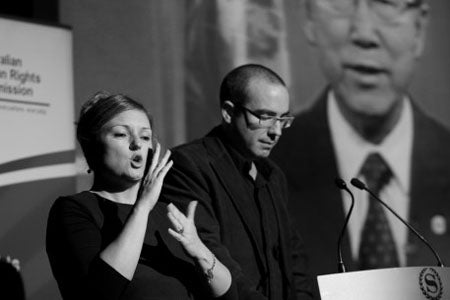
...............
An Auslan signer interprets for the audience after MC, Mr Julian Morrow, introduces a specially recorded Human Rights Day message from UN Secretary-General, Ban Ki-moon.
2.9 2008 Human Rights Photography Competition
The 2008 Human Rights Photography Competition was held in 2008 under the theme, Dignity and justice for us all, the official theme of the UN’s 2008 Human Rights Day.
Entries for the 2008 competition closed on 7 November 2008. 380 entries were received, from which the panel of three judges (Commissioner Tom Calma, Ms Julia Dean from the United Nations Information Centre in Canberra and Dr Phil George from the College of Fine Arts, University of New South Wales) compiled a shortlist of 30 photographs.
Winners were selected in three categories: 18 and above (age at 30 June 2008), Under 18 (Male) and Under 18 (Female). Respectively, they were Belinda Mason from Sydney for her photograph entitled Intervention, Luke Urquhart from Nambucca Heads, NSW, for Laughter is a smile that bursts and Ashley Evans from Doncaster, Vic, for Jack and Jill.
The 2008 Human Rights Photography Competition was sponsored by Digital Camera Warehouse, Australian Photography magazine, Vision Graphics and Actnow.com. Category winners received a $500 voucher for the Digital Camera Warehouse and runners-up received a 12-month subscription to Australian Photography Magazine.
The winners and shortlisted entries were displayed in the foyer of the Sheraton on the Park Hotel at the Human Rights Medals and Awards ceremony on 10 December 2008 where two of the winners were presented with their awards. The photographs were also exhibited at the Kerry Packer Civic Gallery in the Hawke Centre of the University of South Australia from 19 January to 27 February 2009 under an arrangement with the university.
Information about the 2008 Human Rights Photography Competition is available on the Commission website at: www.humanrights.gov.au/photo_comp/index.html.
